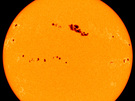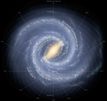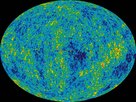Learn about astronomy
Why astronomy?
Astronomy is one of the oldest sciences. It studies the celestial bodies: planets, moons, meteorites and stars; it explores galaxies and investigates cosmic radiation, and it tries to shed light on the origins and evolution of the universe.
 © Camille Flammarion (1888) |
This widely reproduced woodcut was published for the first time in 1888 in Camille Flammarion's book "L'atmosphère". It depicts a man who sticks his head through the firmament in order to behold the workings of the universe.
It has also always had a practical and useful side. The ancient Egyptians conducted systematic observations of the celestial bodies that are visible to the unaided human eye. The observed regularities in their movements made it possible to keep track of the seasons and to till the land before the River Nile came into flood. Throughout history, kings, priests and taxmen depended on reliable calendars that were invariably based on the movements of the Sun and the Moon. Seafarers learned how to use the positions of celestial bodies for navigation. All these observations eventually also allowed scientists to deduce the shape and motion of the Earth.
Fun, excitement and a deeper understanding of the world
Today, astronomy is also a very rewarding hobby for many people. Whether the aim is to understand simple physical phenomena in the universe, to observe the stars using a homemade telescope, or to test visionary ideas from a science-fiction novel against Einstein's theory of relativity, astronomy allows you to leave everyday life behind, to expand your horizons and to explore the conditions of human existence. If you would like to know more about the universe you live in, you can find information about astronomical societies, observatories, planetariums and research institutions from all over the world at astronomyclubs.com2009 is the International Year of Astronomy. Let us enjoy astronomy together.
German Aerospace Center
Learn about astronomy
Why astronomy?
Astronomy is one of the oldest sciences. It studies the celestial bodies: planets, moons, meteorites and stars; it explores galaxies and investigates cosmic radiation, and it tries to shed light on the origins and evolution of the universe.
 © Camille Flammarion (1888) |
This widely reproduced woodcut was published for the first time in 1888 in Camille Flammarion's book "L'atmosphère". It depicts a man who sticks his head through the firmament in order to behold the workings of the universe.
It has also always had a practical and useful side. The ancient Egyptians conducted systematic observations of the celestial bodies that are visible to the unaided human eye. The observed regularities in their movements made it possible to keep track of the seasons and to till the land before the River Nile came into flood. Throughout history, kings, priests and taxmen depended on reliable calendars that were invariably based on the movements of the Sun and the Moon. Seafarers learned how to use the positions of celestial bodies for navigation. All these observations eventually also allowed scientists to deduce the shape and motion of the Earth.
Fun, excitement and a deeper understanding of the world
Today, astronomy is also a very rewarding hobby for many people. Whether the aim is to understand simple physical phenomena in the universe, to observe the stars using a homemade telescope, or to test visionary ideas from a science-fiction novel against Einstein's theory of relativity, astronomy allows you to leave everyday life behind, to expand your horizons and to explore the conditions of human existence. If you would like to know more about the universe you live in, you can find information about astronomical societies, observatories, planetariums and research institutions from all over the world at astronomyclubs.com2009 is the International Year of Astronomy. Let us enjoy astronomy together.
German Aerospace Center









